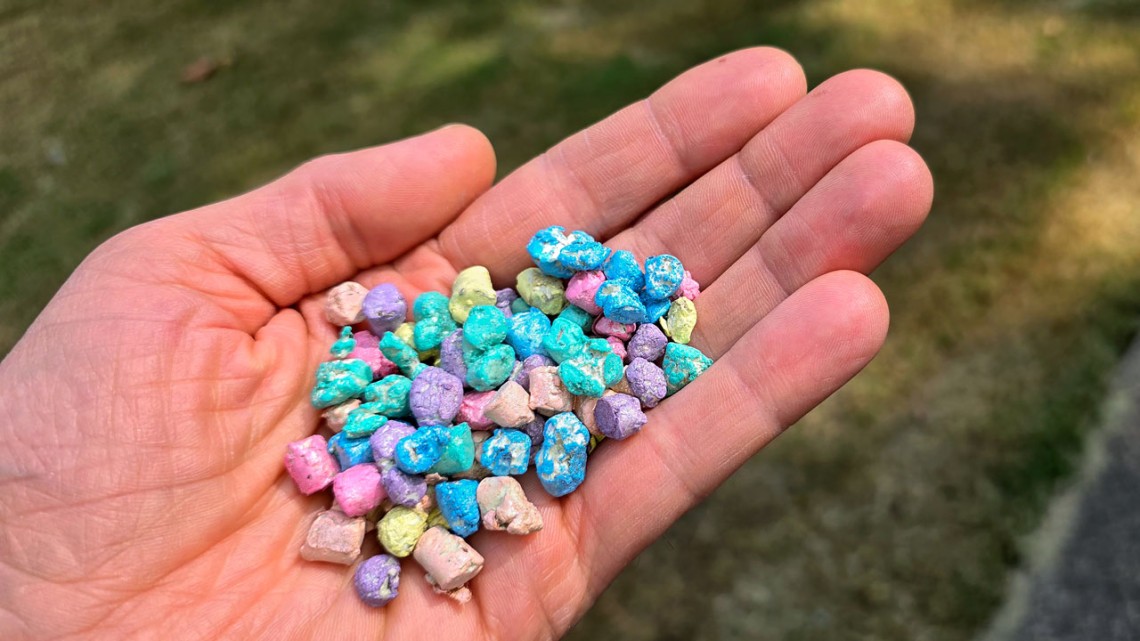Ithaca, New York, USA
September 11, 2024
 Multiseed pellets allow farmers to use corn planting machines to plant milkweed and wildflowers. - Credit: Kannar Earth Science/Provided
Multiseed pellets allow farmers to use corn planting machines to plant milkweed and wildflowers. - Credit: Kannar Earth Science/Provided
Crop fields are low in biodiversity, but farmers may soon be part of the solution thanks to a Cornell innovation that allows growers to use corn or other crop seed planting machines to plant strips of milkweed or wildflowers next to their fields.
Cornell researchers are currently working with industry partners to scale up a multiseed pellet technology that are the same shape and density as corn seeds, so they work in planters.
As a proof of principle, the team began with milkweed seed pellets, as described in a 2023 paper, and have now expanded to corn-shaped pellets for milkweeds and wildflowers. They recently planted the pellets at a Cornell research farm in Freeville, New York, which will allow the seeds to break dormancy in the winter and sprout and emerge in spring of 2025. Improvements in the pelleting technology are being pursued to make sure the pellets work efficiently in the planters, as an earlier version proved too large for planting equipment.
“Typically, milkweed plants are grown out from seedlings and then transplanted, a process that has limited farmer adoption of flowering strips near cornfields,” said Antonio DiTommaso, professor in the Soil and Crop Sciences Section in the School of Integrative Plant Science in the College of Agriculture and Life Sciences. “And, you know, using transplants is ok, for small areas to be planted, but it’s still time-consuming and costly.”
DiTommaso, John Losey, professor of entomology in CALS, and Alan Taylor, professor of seed biology and technology at Cornell AgriTech in CALS, have worked together to develop the pellets, called Multiseed Zea Pellets. The team has been collaborating with industry partners Kannar Earth Science (to tweak formulations and scale up the pellets to produce thousands for resale) and Corteva Agriscience (for distributing the seeds).
Scientists and government agencies have long advocated for farmers to plant wildflower buffer strips to counter low biodiversity around crops. That lack of biodiversity leads to fewer beneficial insects and the loss of the ecosystem services they provide, such as pollinating plants to increase yields or attracting predator wasps or ladybugs that prey on crop pests.
The seed pellet idea began somewhat casually a decade ago, when DiTommaso and Losey discussed whether farmers could simply add milkweed or wildflower seeds in their corn, soybean or small grain planting machines. But they soon realized seeds in these planting machines require an intended, uniform size and density.
“You’re not going to ask farmers to buy another piece of equipment to plant wildflowers, even if a grower is very supportive and believes in the cause,” DiTommaso said. That was when they came up with the idea of developing seed pellets with the same shape and density that planters use.
“It allows farmers to now plant with the standard planting equipment that they already have,” Losey said.
The pellets – which each hold multiple seeds of a single species – have been formulated with three different milkweeds (common, swamp and butterfly) and three kinds of wildflowers (purple coneflower, wild bergamot and black-eyed Susan).
Led by Taylor, the researchers used 3D-molding technology to simulate the corn seed’s size and shape. The pellets are composed of diatomaceous earth, wood powder and maltodextrin, a digested cornstarch that acts as a binder. They then add water to make a dough, and fold in seeds – three seeds per pellet for milkweed.
The original idea was that these pellets could be included in bags of corn seeds, an idea called “a refuge in a bag.”, and could then be interspersed between crops in fields. “The composition that was used would make the density – the specific gravity of the pellets – similar to corn so they wouldn’t settle to the bottom or top of the bag,” Taylor said.
They soon had to shift their thinking, as 95% of corn and soy is Roundup Ready, meaning the crops are resistant to glyphosate herbicide for controlling weeds, and in the process also kill beneficial wildflowers and milkweeds.
“It was really effective at controlling milkweed, and so milkweed declined, and then monarch butterflies declined, which, by the way, is the national insect, and numbers of monarchs have dropped so low that it is under consideration for listing as an endangered species” Losey said, adding that milkweed is the sole food for monarch caterpillars. Computer models suggest, due to the declines, that monarch populations are unstable, Losey said, and they require more milkweed, and wildflowers for nectar-feeding adult butterflies.
In order to truly improve biodiversity, large-scale plantings of milkweed and wildflower strips are required. “Not that there’s anything wrong with people planting milkweed in their backyards, but we need them at the landscape level,” DiTommaso said. Experts suggest that refuges should encompass up to 20% of a farmer’s field to have a significant effect. Until a viable alternative to Roundup Ready crops exists, refuge plants will need to remain as buffer strips next to crop fields.
“When I’m talking to farmers, and I say, you could use the same planter to put this down, they look at me, they’re listening,” DiTommaso said. “This idea was born out of almost abstract discussions a decade ago, and now, it’s happening.”
Marius Weigert, director of innovation and engagement in the Research and Innovation Office at CALS, has connected the team with industry partnerships, sourced funding and helped facilitate transferring the technology to growers.
The researchers have a recently approved patent for the Multiseed Zea Pellet technology through Cornell’s Center for Technology Licensing.
The project is funded by a three-year, $1 million grant from the National Science Foundation, and Corteva Agriscience.